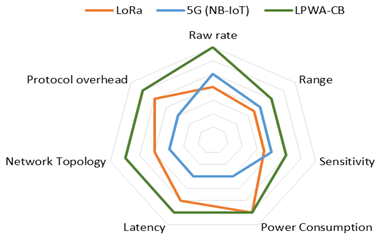
News
Leti says its LPWA out-performs LoRa and NB-IoT
Leti’s LPWA uses its Turbo-FSK waveform which is a flexible approach to the physical layer. It also relies on channel bonding, the ability to aggregate non-contiguous communication channels to increase coverage and data rates.
The results indicate the new technology is especially suitable for long-range massive machine-type communication (mMTC) systems. These systems, in which tens of billions of machine-type terminals communicate wirelessly, are expected to proliferate after 5G networks are deployed, beginning in 2020.
Cellular systems designed for humans do not adequately transmit the very short data packets that define mMTC systems.

Figure 1: Performance chart comparison
Designed to demonstrate the performance and flexibility of the new waveform, the field-trial results stem primarily from the system’s flexible approach of the physical layer. The flexibility allows data-rate scaling from 3Mbit/s down to 4kbit/s, when transmission conditions are not particularly favorable and/or a long transmission range is required.
Under favorable transmission conditions, e.g. a shorter range and line of sight, the Leti system can select high data rates using widely deployed single-carrier frequency-division multiplexing (SC-FDM) physical layers to take advantage of the low power consumption of the transmission mode.
Transmission conditions
Under more severe transmission conditions, the system switches to more resilient high-performance orthogonal frequency division multiplexing (OFDM).
When both very long-range transmission and power efficiency are required, the system selects Turbo-FSK, which combines an orthogonal modulation with a parallel concatenation of convolutional codes and makes the waveform suitable to turbo processing.
The selection is made automatically via a medium access control (MAC) approach optimized for IoT applications.
“Leti’s Turbo-FSK receiver performs close to the Shannon limit, which is the maximum rate that data can be transmitted over a given noisy channel without error, and is geared for low spectral efficiency,” says Leti’s Vincent Berg.
“Moreover, the waveform exhibits a constant envelope, i.e. it has a peak-to-average-power ratio (PAPR) equal to 0dB, which is especially beneficial for power consumption. Turbo-FSK is therefore well adapted to future LPWA systems, especially in 5G cellular systems.”
Different waveforms
In the new system, the MAC layer exploits the advantages of the different waveforms and is designed to self-adapt to context, i.e. the usage scenario and application.
It optimally selects the most appropriate configuration according to the application requirements, such as device mobility, high data rate, energy efficiency or when the network becomes crowded, and is coupled with a decision module that adapts the communication depending on the radio environment.
The optimization of the application transmission requirements is realized by the dynamic adaptation of the MAC protocol, and the decision module controls link quality.